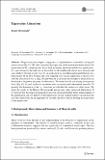Eigenvalue Attraction
Author(s)
Movassagh, Ramis
Download10955_2015_Article_1424.pdf (3.539Mb)
PUBLISHER_POLICY
Publisher Policy
Article is made available in accordance with the publisher's policy and may be subject to US copyright law. Please refer to the publisher's site for terms of use.
Terms of use
Metadata
Show full item recordAbstract
We prove that the complex conjugate (c.c.) eigenvalues of a smoothly varying real matrix attract (Eq. 15). We offer a dynamical perspective on the motion and interaction of the eigenvalues in the complex plane, derive their governing equations and discuss applications. C.c. pairs closest to the real axis, or those that are ill-conditioned, attract most strongly and can collide to become exactly real. As an application we consider random perturbations of a fixed matrix M. If M is Normal, the total expected force on any eigenvalue is shown to be only the attraction of its c.c. (Eq. 24) and when M is circulant the strength of interaction can be related to the power spectrum of white noise. We extend this by calculating the expected force (Eq. 41) for real stochastic processes with zero-mean and independent intervals. To quantify the dominance of the c.c. attraction, we calculate the variance of other forces. We apply the results to the Hatano-Nelson model and provide other numerical illustrations. It is our hope that the simple dynamical perspective herein might help better understanding of the aggregation and low density of the eigenvalues of real random matrices on and near the real line respectively. In the appendix we provide a Matlab code for plotting the trajectories of the eigenvalues.
Date issued
2015-12Department
Massachusetts Institute of Technology. Department of MathematicsJournal
Journal of Statistical Physics
Publisher
Springer US
Citation
Movassagh, Ramis. “Eigenvalue Attraction.” J Stat Phys 162, no. 3 (December 16, 2015): 615–643.
Version: Author's final manuscript
ISSN
0022-4715
1572-9613